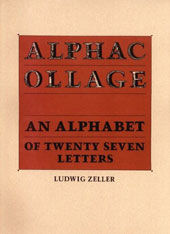The Porcupine's Quill
Celebrating forty years on the Main Street
of Erin Village, Wellington County
BOOKS IN PRINT
Alphacollage by Ludwig Zeller
Zeller draws his images in both language and art from a variety of sources, but they derive most often from the desert world of his youth, and the mechanical world that humans have created around themselves. The letters are twined with eels, snakes, snails, lizards; primitive or common devices such as forceps, pulleys, scissors, musical instruments; and quite often the moving parts of the human skeleton.
‘Alphacollage opens with a surrealistic essay which also acts as an introduction to the book. As with most Zeller writings, this is printed in English, French and Spanish. ‘‘Cutting Out Letters Means ...’’ explores the birth of language in its literal, imaginative and artistic forms. This of course relates intrinsically to Alphacollage, which presents each letter of the alphabet as a collage. Zeller is concerned with language as it defines the relationship between dreams and reality, and this reflects Breton’s view that surrealism is trying to express the ‘‘prime matter of language’’.
‘When the reader examines the pages of Alphacollage, it is possible to share Zeller’s wonder at creation. Every letter of the alphabet is composed of many and minute figures, and each is printed on a seperate page. These tiny details were gleaned from nineteenth-century anatomy and science texts, and encyclopedias, and this gives the book an exciting, alchemical tone. It is easy to go through the book endlessly and still find or impose new pictures and concepts.
‘Zeller draws his images in both language and art from a variety of sources, but they derive most often from the desert world of his youth, and the mechanical world that humans have created around themselves. The letters are twined with eels, snakes, snails, lizards; primitive or common devices such as forceps, pulleys, scissors, musical instruments; and quite often the moving parts of the human skeleton.
‘It must be noted that the collages have been printed beautifully by the Porcupine’s Quill. As usual, this press has turned out a high quality collectible volume.
‘Alphacollage is an intricately fascinating book. In its clarity it is a personal, historical and vital language for artists of all kinds.’ -- Canadian Book Review Annual

1989—Der Schoenste Bucher aus Aller Welt,
Runner-up

1980—Art Directors Club of New York,
Commended
Review quote
‘When we learn the alphabet we really don’t experience it as an empty and rigorously static form, although we learn to use it that way. Even while our fingers learn parade-square discipline we find certain movements especially difficult or satisfying (‘‘writing R makes my hand go smooth’’), develop fancy ways to make the initial letters of our own names, and secretly grow landscapes for each letter to live in. One kid I know tried to make each letter with her body, which caused some muscle strain and frustration. Secretly, we give life to letters, character to the characters.
‘There is great appeal in Chinese characters because they preserve traces of thingness in the symbol, keeping in touch with nature by long distance while working as tools of culture. Alphacollage seems to satisfy some of that wish to get back to body, but there’s an important difference. Picture writing is, after all, as prescriptive as phonetic script: if you want to root the Chinese character for ‘‘east’’ back to the concrete you are pretty well obliged to see it as the rising sun entangled in the branches of a tree. But it is part of the complex nature of Alphacollage that its images (as opposed to its signs) should wear their arbitrariness, the fact that other images would be selected by other minds or by the same mind under under circumstances. Because they claim neither permanence nor universality (everything in collage is borrowed) the images pull against the stern system to which the letter, as sign, is connected, and testify to the abundant, playful, transitory world of the imagination.’
—Don McKay, Brick
Ludwig Zeller was born in 1927, in Rio Loa, in the desert of Atacama, in the north of Chile. He and his wife, Susanna Wald, moved to Toronto in 1971 where they published surrealist texts under the imprint of Oasis publications and exhibited his collages. He has published many books, including Woman in Dream (1975); When the Animal Rises from the Deep the Head Explodes (1976); the three volume Spanish-English set of Circe’s Mirrors, Visions and Wounds, and Wanders in the Mandala (1978); and In the Country of the Antipodes (1979).
The Porcupine's Quill would like to acknowledge the support of the Ontario Arts Council and the Canada Council for the Arts for our publishing program. The financial support of the Government of Canada through the Canada Book Fund (CBF) is also gratefully acknowledged.




